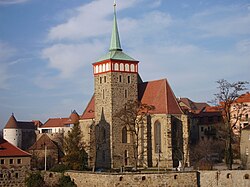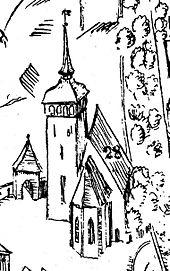Michaeliskirche (Bautzen)
| Michaeliskirche | |
|---|---|
 View from the southwest |
|
| Data | |
| place | Bautzen , Saxony |
| Construction year | after 1429 |
| height | 45 m |
| Floor space | 640 m² |
| Coordinates | 51 ° 10 '51.5 " N , 14 ° 25' 15.4" E |
The Michaeliskirche ( Upper Sorbian Michałska cyrkej ) in Bautzen is located near the Alte Wasserkunst on the southwest arch of the rock spur above the Spree , on which the old town of Bautzen was built. The space between the church, the water art and the inner and outer city walls is known as the Wendish churchyard .
The ensemble of water art and Michaeliskirche is the landmark of the city of Bautzen. In stylized form, it was used for many urban signs and lettering. After the famous Dresden buildings and Moritzburg Castle , it is also one of the most frequently used motifs for tourist advertising in Saxony .
Emergence
In the course of the Hussite Wars , Bautzen was besieged from the west in 1429 . This point represented one of the weakest points of the city fortifications, as in front of the originally running city wall (the remains of which can still be seen today) there was a plateau, thus today's church square, on which the attackers camped. The inhabitants bravely defended their city and when the attacks by the Hussites were at their greatest, the archangel Michael is said to have appeared in the sky, swung his sword and helped the Bautzen people to repel the attackers. As a thank you, the citizens later built a chapel at this point and named it “St. Michael". The Michaeliskapelle was first mentioned in 1473. The city wall was later relocated so that it adjoined the old water art and included the plateau and the church square.
history
The mentioned chapel forms the eastern part of the church, in 1495 the tower was built on the south side and the nave in the west . By 1520 the vault and roof were completed. Since then the church has been called "Michaeliskirche". After the Reformation and the arrival of Protestantism in Upper Lusatia , no services were held in the church for 99 years. It was not until the summer of 1619 that Protestant services in Sorbian were allowed in the Kingdom of Bohemia, to which Bautzen then belonged. The Bautzen city council set up the Michaeliskirche as the parish church of the Protestant Sorbs and in September 1619 a service was held again for the first time. Until 1836, over 200 years, the parish was purely Sorbian. From this year, German church services were gradually introduced, initially once a month, later more often. Today the Sorbian service takes place once a month.
During the first big fire in 1634 the church was only slightly damaged and the roof burned out. But although there were about 5 tons of powder in the church, it did not go up in fire. As one of the few remaining buildings, the Michaeliskirche survived the city fire and in the meantime served as a place of worship for the Petri congregation, as the Petridom was destroyed.
Inside the church are the altar made by Stöckel and Kanderbach in 1693 and the organ consecrated in autumn 1784. During the renovation in 1892, the galleries were built, the south-facing windows were installed and the stairwells were placed on the outside. In the course of the redesign, a new owl organ and three new church bells were installed.
In the 19th and early 20th centuries there was also a separate Michaelis School, which was owned by the community. The Michaeliskirche did not have an attached cemetery due to lack of space, as the Wendish churchyard functioned as part of an important traffic connection from the Spreetal up to the Inner Lauentor and into the old town.
At the end of the Second World War during the Battle of Bautzen , the tower dome burned out, but a bell from 1929 was preserved and was the only one in the city to ring in the New Year's 1946. During renovations from 1964 to 1976, most of the alterations made in 1892 were reversed, the extensions removed and the windows exposed again, and in 1976 a new organ was again installed by the Eule company. In 1992 the church got a new bell and a facade renovation has been in progress since 2005.
literature
- Jan Mahling (Ed.): St. Michael Bautzen. Church, parish, villages. Bautzen 2019, ISBN 978-3-7420-2559-3
- Cornelius Gurlitt : The Michaeliskirche. In: Descriptive representation of the older architectural and art monuments of the Kingdom of Saxony. 33. Booklet: Bautzen (city) . CC Meinhold, Dresden 1909, pp. 69-76.
- Christine Seele, Siegfried Seifert , Jürgen Matschie: Bautzen and its churches. A little ecumenical church leader. Leipzig 1996, ISBN 3-7462-1118-2 , pp. 41-44.
- Constanze Knappe: Bautzen's monuments. Lausitz printing and publishing house, Bautzen 1999, series 5.
- Johannes Mahling: Churches between Königsbrück and Weißenberg. Lusatia-Verlag, Bautzen 2011, ISBN 978-3-936758-75-7 , pp. 22-23.
Web links
Individual evidence
- ↑ Kołojězba po wosadźe Michałskeje cyrkwje. In: Serbske Nowiny , March 25, 2019, p. 2
- ↑ Uwe Menschner: Fresh cell treatment for the organ of the Michaelskirche. In: Lausitzer Rundschau , November 9, 2013.


